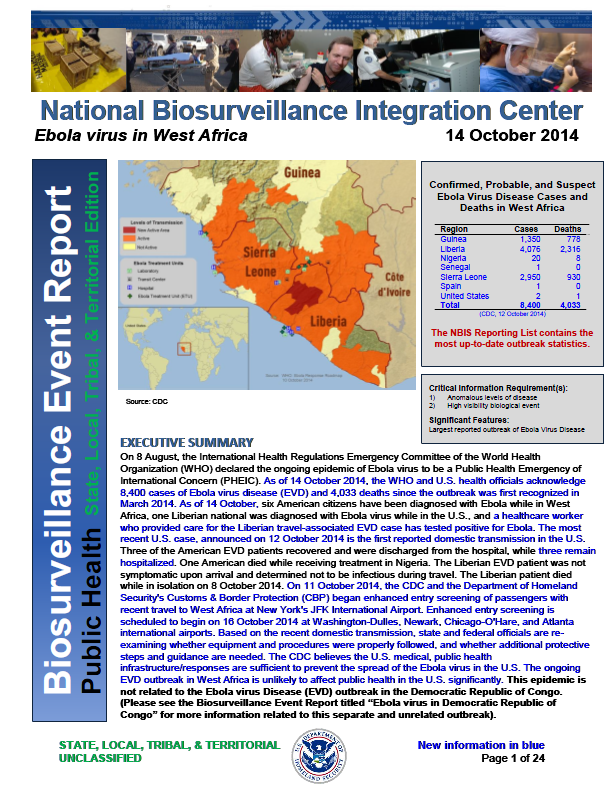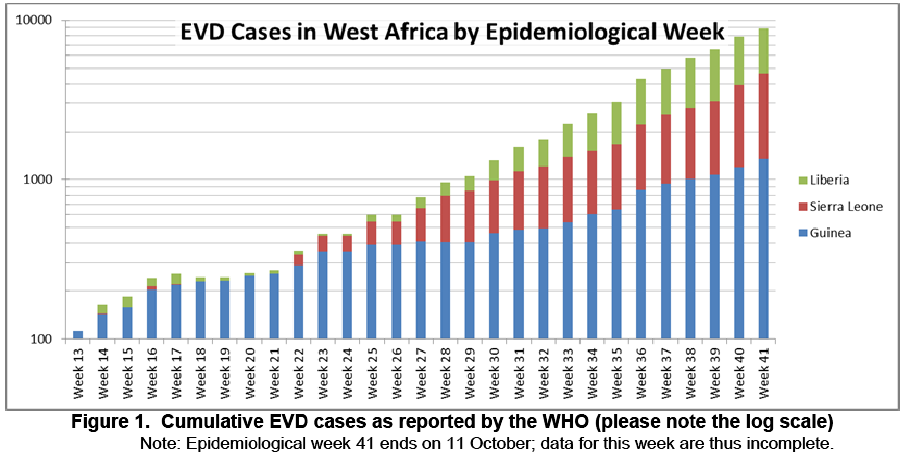National Biosurveillance Integration Center Ebola virus in West Africa
- 22 pages
- October 1, 2014
On 8 August, the International Health Regulations Emergency Committee of the World Health Organization (WHO) declared the ongoing epidemic of Ebola virus to be a Public Health Emergency of International Concern (PHEIC). As of 14 October 2014, the WHO and U.S. health officials acknowledge 8,400 cases of Ebola virus disease (EVD) and 4,033 deaths since the outbreak was first recognized in March 2014. As of 14 October, six American citizens have been diagnosed with Ebola while in West Africa, one Liberian national was diagnosed with Ebola virus while in the U.S., and a healthcare worker who provided care for the Liberian travel-associated EVD case has tested positive for Ebola. The most recent U.S. case, announced on 12 October 2014 is the first reported domestic transmission in the U.S. Three of the American EVD patients recovered and were discharged from the hospital, while three remain hospitalized. One American died while receiving treatment in Nigeria. The Liberian EVD patient was not symptomatic upon arrival and determined not to be infectious during travel. The Liberian patient died while in isolation on 8 October 2014. On 11 October 2014, the CDC and the Department of Homeland Security’s Customs & Border Protection (CBP) began enhanced entry screening of passengers with recent travel to West Africa at New York’s JFK International Airport. Enhanced entry screening is scheduled to begin on 16 October 2014 at Washington-Dulles, Newark, Chicago-O’Hare, and Atlanta international airports. Based on the recent domestic transmission, state and federal officials are re- examining whether equipment and procedures were properly followed, and whether additional protective steps and guidance are needed. The CDC believes the U.S. medical, public health infrastructure/responses are sufficient to prevent the spread of the Ebola virus in the U.S. The ongoing EVD outbreak in West Africa is unlikely to affect public health in the U.S. significantly. This epidemic is not related to the Ebola virus Disease (EVD) outbreak in the Democratic Republic of Congo. (Please see the Biosurveillance Event Report titled “Ebola virus in Democratic Republic of Congo” for more information related to this separate and unrelated outbreak).
EVENT FEATURES
On 12 October 2014, the Centers for Disease Control and Prevention (CDC) announced that a healthcare worker at Texas Presbyterian Hospital had tested positive for Ebola virus. The healthcare worker is a nurse who had cared for the Liberian national that was diagnosed on 30 September 2014 with Ebola virus disease (EVD) at the same Texas hospital. This marks the first domestic transmission of EVD in the U.S. The healthcare worker had been self-monitoring for fever and EVD-symptoms. The patient was isolated after the initial report of fever and is reported to be in stable condition at Texas Presbyterian Hospital. The patient has received a blood transfusion from one of the American medical aid workers who was infected while providing care in Liberia that has since recovered.
As of 13 October 2014, the CDC and local health officials were compiling a list of healthcare workers who were involved in the care of the Liberian national who subsequently died.
State and federal health officials are examining existing Ebola-related protocols at healthcare settings, determining whether equipment and procedures were properly followed in Texas, and whether additional protective steps and guidance are needed.
As of 14 October 2014, six American citizens have been diagnosed with Ebola while in West Africa, one Liberian national was diagnosed with Ebola virus in the U.S., and one U.S. healthcare worker was domestically infected while caring for the Liberian national. A single case died while in Nigeria. Five were diagnosed in West Africa before traveling to the U.S. for treatment. Of these five, three have recovered and have been discharged from the hospital, and two remain hospitalized.
As of 14 October 2014, the WHO and U.S. health officials acknowledge 8,400 cases of EVD and 4,033 deaths since the outbreak was first recognized in March 2014.
On 11 October 2014, the CDC and the Department of Homeland Security’s Customs & Border Protection (CBP) began enhanced entry screening of passengers with recent travel to West Africa at New York’s JFK International Airport. Enhanced entry screening is scheduled to begin on 16 October 2014 at Washington-Dulles, Newark, Chicago-O’Hare, and Atlanta international airports. These five U.S. airports are reported to receive approximately 94% of travelers originating from Ebola-stricken nations of Guinea, Liberia, and Sierra Leone.
On 6 October 2014, the WHO released a situational assessment describing the known routes of transmission of the Ebola virus among humans. In the assessment the WHO re-emphasized that Ebola virus is not an airborne virus and there is no evidence that the viral mode of transmission has changed from previous outbreaks.
On 6 October 2014, Spanish health officials announced the first instance of domestic EVD transmission known to have occurred outside the epidemic region in West Africa. The patient, a nurse assistant, assisted in the care of a Spanish missionary that was transported to Madrid, Spain after developing symptoms of EVD in West Africa.
On 5 October 2014, Uganda health officials released a statement confirming a fatal case of Marburg in a healthcare worker. One contact of the individual developed symptoms and has been placed in isolation. The last recorded outbreak of Marburg virus, a virus closely related to Ebola virus, occurred in Kabale, Uganda during 2012.
On 2 October 2014, NBC news has reported that a freelance American cameraman contributing to coverage in Liberia has tested positive for Ebola virus. The infected American cameraman was transported to the U.S. for treatment at the Nebraska Medical Center.
On 30 September 2014, the CDC announced that a traveler was diagnosed with EVD while receiving medical care at the Texas Health Presbyterian Hospital in Dallas, Texas. This is the first case of EVD diagnosed in the U.S. The patient left Liberia on 19 September and arrived in the U.S. on 20 September 2014. The traveler, reported to be a Liberian resident, develop symptoms on 24 September, sought medical care on 26 September, and was admitted to the hospital and placed in isolation on 28 September. The Liberian EVD patient identified in the U.S. traveled to Texas from Liberia while asymptomatic and was determined not to be infectious during travel. The patient died while in isolation on 8 October 2014. Public health officials continue to monitor contacts of the patient’s domestic U.S. contacts.
On 26 August 2014, the Ministry of Health, Democratic Republic of Congo (DRC) notified the World Health Organization (WHO) of an outbreak of Ebola Virus Disease (EVD) in a rural region of the northern providence of Equateur after two patients tested positive for Ebola virus. The Ebola outbreak in DRC is independent and unrelated to the Ebola Virus Disease outbreak in West Africa (Please see the Biosurveillance Event Report titled “Ebola virus in the Democratic Republic of Congo” for more information related to that outbreak).
…


